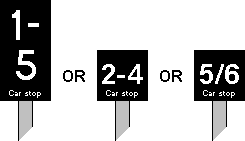|
|
|
|
|
|
At station platforms and other places where trains regularly come to a stand, markers may be provided to assist drivers in stopping their trains at a specific position, where this is advantageous or important for some reason.
The general provision of stop markers at station platforms was initially confined to lines where an intensive passenger service was worked by electric or diesel multiple unit trains. Stop markers indicated the point where the front of a train should stop to achieve optimum train positioning, with a view to minimising station dwell times.
|
In 1915/1916, the London & South Western Railway electrified its suburban lines in southwest London with the 600 V DC third rail system. Stop markers comprising a white figure on a blue square [21.1] were provided at stations. The figure denoted the stopping position for trains composed of the corresponding number of vehicles ('cars'). |
|
As the use of stop markers spread to other parts of the rail network (typically in connection with suburban electrification schemes), their colours conformed to the colour scheme of the company or British Railways region concerned [21.2 - 21.5], as was present on ordinary station signage provided for the guidance of passengers. The Eastern Region's stop markers closely resembled the earlier L&SWR style (see [21.1]), having white figures on a blue background.
 |
 |
|
[21.2] Stop Marker.
Area: Southern Railway Usage: High Status: Historical |
[21.3] Stop Marker.
Area: London Midland Region Usage: Medium Status: Historical |
|---|---|
 |
 |
|
[21.4] Stop Marker.
Area: Western Region Usage: Medium Status: Obsolescent |
[21.5] Stop Marker.
Area: Scottish Region Usage: Medium Status: Historical |
Where the stopping points for trains of different lengths coincided, individual stop markers for each length of train were co-located, or a single stop marker was provided which showed more than one figure to denote the different train lengths it applied to [21.6 & 21.7]. Where a letter "S" was shown [21.8] instead of a figure, this indicated a stop marker that applied to trains of all lengths.
 |
 |
 |
|
[21.6] Stop Marker.
Area: London Midland Region Usage: Medium Status: Historical |
[21.7] Stop Marker.
Area: Eastern Region Usage: Medium Status: Historical |
[21.8] "S" Stop Marker (e.g. Southern Railway).
Area: Various Usage: High Status: Historical |
|---|
|
An illuminated marker board was fixed to the post of the signal controlling departures from the terminal station at Guisborough (LNER) to assist drivers of passenger trains being propelled into the station. The marker board faced towards the track and was diamond shaped with the word "seven" painted on it [21.9]. A train propelling seven bogie vehicles into the platform was required to stop with the locomotive cab opposite the marker board. Shorter trains could pass the board by a corresponding distance. |
|
|
At a few stations, signs or indicators are provided to mark the point at which platforms are subdivided for platform sharing purposes. Certain platforms at Bishop's Stortford, Royston and Witham stations on the Great Eastern lines, which are signalled for working in both directions, were subdivided by the provision of "stop here" indicators. These indicators are normally extinguished, but when illuminated they display the words "stop here" [21.10]. The driver of a train entering the platform must stop at an illuminated "stop here" indicator, and must not move forward unless the signal ahead has cleared or permission is given. |
|
When construction work is taking place at a station and the full length of the platform is not available for use, a temporary board worded "trains stop here" [21.11] may be erected to indicate the point at which all trains must stop. On the London Midland Region, an illuminated indicator displaying a letter "S" [21.12] was used for this purpose.
 |
 |
|
[21.11] "Trains Stop Here" Board.
Area: All Areas Usage: High Status: Current |
[21.12] "S" Indicator.
Area: London Midland Region Usage: High Status: Historical |
|---|
|
A marker board may be installed to indicate where freight trains of a specified length should come to a stand. Originally, the train length on these boards was expressed in terms of the number of wagons in the train [21.13]. There may be a series of similar boards located along the lineside, applicable to trains of different lengths. |
|
A car stop marker may show more than one figure where the stopping points for trains of different lengths coincide [21.15 - 21.17].
 |
 |
 |
[21.15] Car Stop Marker.

Area: All Areas Usage: High Status: Current |
[21.16] Car Stop Marker.
Area: Various Usage: Low Status: Uncertain |
[21.17] Car Stop Marker.
Area: Various Usage: High Status: Current |
|---|
|
Where a letter "S" is shown [21.18] instead of a figure, this indicates that the marker applies to trains of all lengths. |
|
Marker boards may be installed in connection with shunting movements, e.g. to indicate a position that the train must pass beyond before setting back. In many cases, the marker's position will coincide with a track circuit boundary. There are various forms [21.19 - 21.22].
 |
 |
 |
 |
|
[21.19] Marker Board.
Area: Scottish Region Usage: Low Status: Historical |
[21.20] Marker Board.
Area: Scottish Region Usage: Medium Status: Current |
[21.21] Marker Post.
Area: Scottish Region Usage: Medium Status: Obsolescent |
[21.22] Marker Post.
Area: Scottish and Eastern Regions Usage: Medium Status: Obsolescent |
|---|
|
|